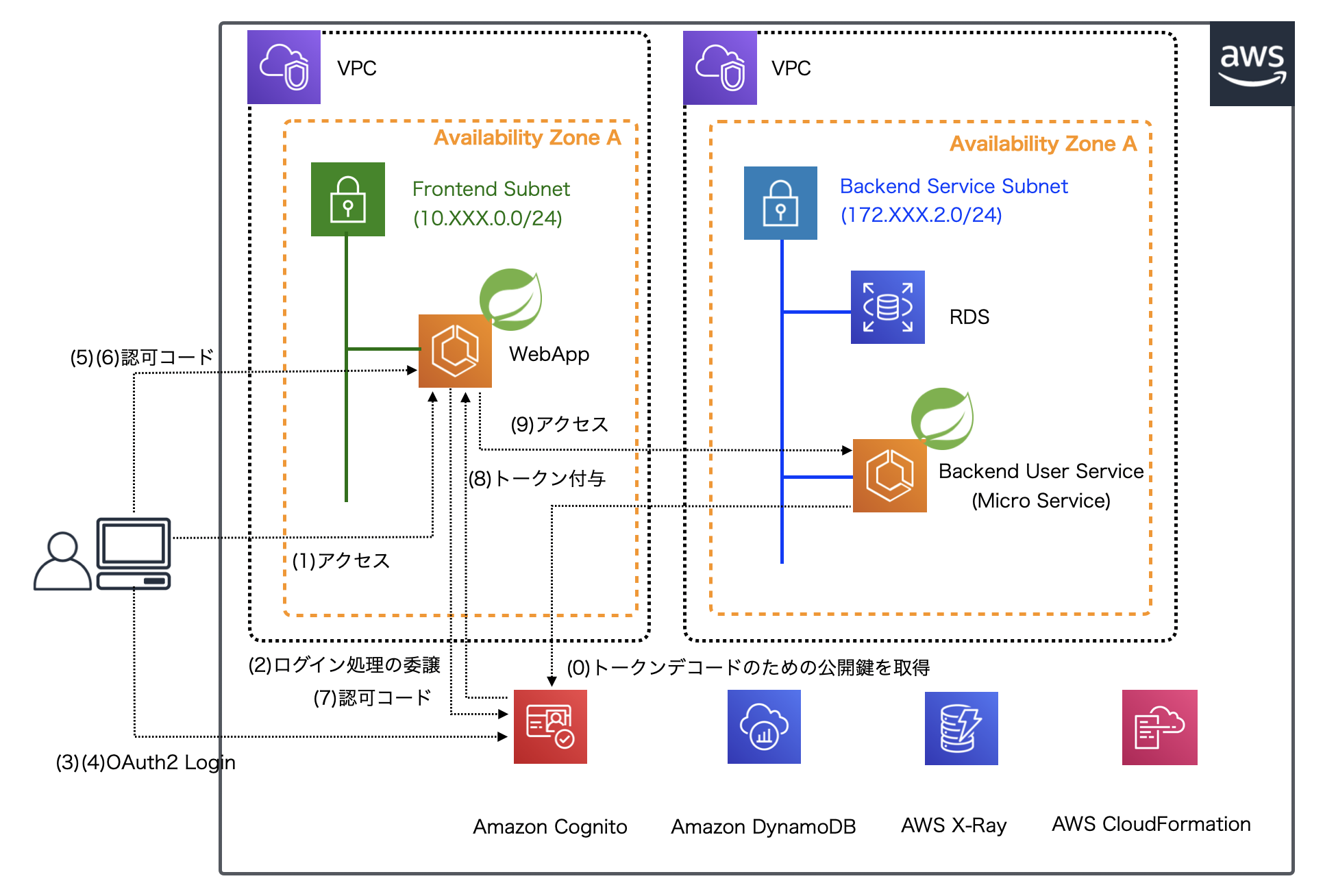【第17回】Amazon Cognito + Spring Sercurityを使ったOAuth2 Loginの実装(6)¶
前回から、以下のイメージのようにOAuth2 Loginをベースとしたアーキテクチャを想定した環境構築を進めています。

前回は、CloudFormationで構築したAmazon Cognitoのアプリクライアントからクライアントシークレットを取得し、 Parameter Storeへ設定するLambdaファンクションを実装しました。今回は引き続き、Cognitoへユーザを登録・サインアップしテータスを更新するLambdaファンクションの実装方法を解説していきます。
なお、実際のソースコードは GitHub 上にコミットしています。以降のソースコードでは本質的でない記述を一部省略しているので、実行コードを作成する場合は、必要に応じて適宜GitHub上のソースコードも参照してください。
Cognitoにユーザを登録するLambdaファンクションの実装¶
続いて、Cognitoユーザプールへユーザを追加するLambdaファンクションを実装します。ファンクションクラスの基本的な構成は、前回実装したParameter Storeへクライアントシークレットを設定するものと同じです。
package org.debugroom.mynavi.sample.aws.microservice.lambda.app.function;
// omit
@Slf4j
public class AddCognitoUserFunction implements Function<Map<String, Object>, Message<String>> { //(A)
@Autowired
ServiceProperties serviceProperties; //(B)
@Autowired
CloudFormationStackResolver cloudFormationStackResolver; //(C)
@Autowired
AWSCognitoIdentityProvider awsCognitoIdentityProvider;
@Override
public Message<String> apply(Map<String, Object> stringObjectMap) {
log.info(this.getClass().getName() + " has started!");
String userPoolId = cloudFormationStackResolver.getExportValue(
serviceProperties.getCloudFormation().getCognito().getUserPoolId()); //(D)
ListUsersRequest listUsersRequest = new ListUsersRequest().withUserPoolId(userPoolId);
ListUsersResult listUsersResult = awsCognitoIdentityProvider.listUsers(
listUsersRequest);
int numberOfCognitoUser = listUsersResult.getUsers().size(); //(E)
List<AttributeType> attributeTypes = new ArrayList<>();
AdminCreateUserRequest adminCreateUserRequest = new AdminCreateUserRequest()
.withUserPoolId(userPoolId)
.withTemporaryPassword("test01");
attributeTypes.add(new AttributeType().withName("family_name").withValue("mynavi"));
attributeTypes.add(new AttributeType().withName("given_name").withValue("taro"));
attributeTypes.add(new AttributeType().withName("custom:isAdmin").withValue("1"));
if(numberOfCognitoUser != 0){
adminCreateUserRequest.withUsername("taro.mynavi" + Integer.toString(numberOfCognitoUser));
attributeTypes.add(new AttributeType()
.withName("custom:loginId").withValue("taro.mynavi" + Integer.toString(numberOfCognitoUser)));//(F)
}else {
adminCreateUserRequest.withUsername("taro.mynavi");
attributeTypes.add(new AttributeType().withName("custom:loginId").withValue("taro.mynavi"));
}
adminCreateUserRequest.withUserAttributes(attributeTypes);
AdminCreateUserResult adminCreateUserResult = awsCognitoIdentityProvider.adminCreateUser(
adminCreateUserRequest); //(G)
return MessageBuilder.withPayload("Complete!").build();
}
}
| 項番 | 説明 |
| A | java.util.function.Functionを実装します。Input型としてハンドラクラスで生成したMapオブジェクトクラスを、Output型としてorg.springframework.messaging.Messageを指定します。 |
| B | CloudFormationのスタックから取得するためのエクスポート名をプロパティクラスに保持します。実際のエクスポート名は設定ファイルであるapplicaiton.ymlに記載します。設定ファイルの記載要領は AWSで作るクラウドネイティブアプリケーションの応用 第7回 も参考にしてください。 |
| C | CloudFormationのスタックからOutput要素で出力した値を取得するユーティリティクラスをインジェクションします。実装は こちら ですが、CloudFormationのSDKクライアントを使ってエクスポート値を取得します。 |
| D | ユーザプールIDを(C)を使って取得します。 |
| E | ユーザプールに既に登録されているユーザの数を取得します。 |
| F | Eの数に応じて、ログインIDや、ユーザIDに相当するusernameが重複しないように設定します。 |
| G | awsCognitoIdentityProvider.adminCreateUser()メソッドを実行して、ユーザを登録します。 |
Cognitoユーザのサインアップステータスを変更するLambdaファンクションの実装¶
続いて、前節で実装したCognitoユーザ作成後にサインアップステータスを変更するLambdaファンクションを実装します。前節と同様、基本的なLambdaファンクション実装の構成は同じです。
package org.debugroom.mynavi.sample.aws.microservice.lambda.app.function;
import java.nio.charset.StandardCharsets;
import java.util.Base64;
// omit
import javax.crypto.Mac;
import javax.crypto.spec.SecretKeySpec;
@Slf4j
public class ChangeCognitoUserStatusFunction implements Function<Map<String, Object>, Message<String>> {
@Autowired
ServiceProperties serviceProperties;
@Autowired
CloudFormationStackResolver cloudFormationStackResolver;
@Autowired
AWSCognitoIdentityProvider awsCognitoIdentityProvider;
@Autowired
AWSSimpleSystemsManagement awsSimpleSystemsManagement;
@Override
public Message<String> apply(Map<String, Object> stringObjectMap) {
log.info(this.getClass().getName() + " has started!");
String userPoolId = cloudFormationStackResolver.getExportValue(
serviceProperties.getCloudFormation().getCognito().getUserPoolId());
String appClientId = cloudFormationStackResolver.getExportValue(
serviceProperties.getCloudFormation().getCognito().getAppClientId());
String clientSecret = getParameterFromParameterStore(
serviceProperties.getSystemsManagerParameterStore().getCognito().getAppClientSecret(), true);
ListUsersRequest listUsersRequest = new ListUsersRequest().withUserPoolId(userPoolId);
ListUsersResult listUsersResult = awsCognitoIdentityProvider.listUsers(
listUsersRequest); //(A)
listUsersResult.getUsers().stream()
.filter(userType -> Objects.equals(userType.getUserStatus(), "FORCE_CHANGE_PASSWORD")) //(B)
.forEach(userType -> {
AdminInitiateAuthRequest adminInitiateAuthRequest
= adminInitiateAuthRequest(userType.getUsername(), userPoolId, appClientId, clientSecret); //(C)
AdminInitiateAuthResult adminInitiateAuthResult =
awsCognitoIdentityProvider.adminInitiateAuth(adminInitiateAuthRequest); //(D)
if(Objects.equals(adminInitiateAuthResult.getChallengeName(), "NEW_PASSWORD_REQUIRED")){ //(E)
Map<String, String> challengeResponses = new HashMap<>();
challengeResponses.put("USERNAME", userType.getUsername());
challengeResponses.put("NEW_PASSWORD", "test02"); //(F)
challengeResponses.put("userAttributes.given_name",
userType.getAttributes().stream().filter(attributeType ->
Objects.equals(attributeType.getName(), "given_name")).findFirst().get().getValue()); //(G)
challengeResponses.put("SECRET_HASH", calculateSecretHash(appClientId, clientSecret, userType.getUsername())); //(H)
AdminRespondToAuthChallengeRequest adminRespondToAuthChallengeRequest =
new AdminRespondToAuthChallengeRequest()
.withChallengeName(adminInitiateAuthResult.getChallengeName())
.withUserPoolId(userPoolId)
.withClientId(appClientId)
.withSession(adminInitiateAuthResult.getSession()) //(I)
.withChallengeResponses(challengeResponses); //(J)
AdminRespondToAuthChallengeResult adminRespondToAuthChallengeResult =
awsCognitoIdentityProvider.adminRespondToAuthChallenge(adminRespondToAuthChallengeRequest); //(K)
}
});
return MessageBuilder.withPayload("Complete!").build();
}
private AdminInitiateAuthRequest adminInitiateAuthRequest(
String userName, String userPoolId, String appClientId, String clientSecret){
AdminInitiateAuthRequest adminInitiateAuthRequest = new AdminInitiateAuthRequest();
adminInitiateAuthRequest.setAuthFlow(AuthFlowType.ADMIN_USER_PASSWORD_AUTH); //(L)
adminInitiateAuthRequest.setUserPoolId(userPoolId);
adminInitiateAuthRequest.setClientId(appClientId);
Map<String, String> authParameters = new HashMap<>();
authParameters.put("USERNAME", userName);
authParameters.put("PASSWORD", "test01");
authParameters.put("SECRET_HASH", calculateSecretHash(appClientId, clientSecret, userName)); //(M)
adminInitiateAuthRequest.setAuthParameters(authParameters);
return adminInitiateAuthRequest;
}
private static String calculateSecretHash(String userPoolClientId,
String userPoolClientSecret, String userName) { //(N)
final String HMAC_SHA256_ALGORITHM = "HmacSHA256";
SecretKeySpec signingKey = new SecretKeySpec(
userPoolClientSecret.getBytes(StandardCharsets.UTF_8),
HMAC_SHA256_ALGORITHM);
try {
Mac mac = Mac.getInstance(HMAC_SHA256_ALGORITHM);
mac.init(signingKey);
mac.update(userName.getBytes(StandardCharsets.UTF_8));
byte[] rawHmac = mac.doFinal(userPoolClientId.getBytes(StandardCharsets.UTF_8));
return Base64.getEncoder().encodeToString(rawHmac);
} catch (Exception e) {
throw new RuntimeException("Error while calculating ");
}
}
private String getParameterFromParameterStore(String paramName, boolean isEncripted){
GetParameterRequest request = new GetParameterRequest();
request.setName(paramName);
request.setWithDecryption(isEncripted);
return awsSimpleSystemsManagement.getParameter(request).getParameter().getValue();
}
}
| 項番 | 説明 |
| A | ユーザプールID、アプリクライアントIDをCloudFormationのスタック情報から、クライアントシークレットをSystems Manager Parameter Storeから取得し、ユーザプールに存在するユーザの一覧を取得します。 |
| B | 取得したユーザの中で、ステータスが「FORCE_CHANGE_PASSWORD」である初期ユーザを抽出します。 |
| C | Cognitoユーザをサーバ側でサインアップ処理を完了する場合、ユーザプールの認証フロー サーバ側の認証フロー に従って、ユーザを認証するために、AdminInitiateAuthRequestを生成します。 |
| D | AdminInitiateAuth APIを呼び出し、AdminRespondToAuthChallengeRequestの生成に必要なセッションパラメータを含むAdminInitiateAuthResultを取得します。 |
| E | AdminInitiateAuthResultのチャレンジ名が「NEW_PASSWORD_REQUIRED」だった場合に、チャレンジレスポンスを生成し、AdminRespondToAuthChallenge APIを呼び出します。 |
| F | 新たなパスワードを「test02」に変更します。 |
| G | チャレンジレスポンスに「userAttributes.given_name」を含めておきます。これはユーザプールで自身が必須定義した内容に応じて必要となるパラメータです。 |
| H | チャレンジレスポンスに「SECRET_HASH」を含めておく必要があります。SECRET_HASHの実装の詳細は(N)を参照してください。 |
| I | AdminRespondToAuthChallengeRequestにAdminInitiateAuthResultが持つ「セッションパラメータ」が必要になります。詳細は、AdminRespondToAuthChallenge Session も参照してください。 |
| J | AdminRespondToAuthChallengeRequestにチャレンジレスポンスを設定します。 |
| K | AdminRespondToAuthChalleng APIを呼び出して、ユーザのステータスを変更します。 |
| L | AdminInitiateAuthRequestでは、認証フローを「ADMIN_USER_PASSWORD_AUTH」で設定します。 |
| M | AdminInitiateAuthRequestにおいても、「SECRET_HASH」を含めておきます。SECRET_HASHの実装の詳細は(N)を参照してください |
| N | Amazon CognitoのユーザプールAPIは、ユーザプールIDやアプリクライアントID、クライアントシークレットを元にSecretHash値が必要なものがあります。SecretHash値が必要なAPI及びその計算方法は ユーザーアカウントのサインアップと確認 SecretHash 値の計算 を参照してください。 |
今回は、Cognitoユーザプールにユーザを追加し、サインアップステータスを変更するLambdaファンクションを実装しました。 次回は、前回実装したクライアントシークレットをParameter Storeへ登録するLambdaファンクションを含めて、カスタムリソースとして実行するCloudFormationテンプレートを作成し、実行してみます。
著者紹介¶
川畑 光平(KAWABATA Kohei) - NTTデータ エグゼクティブ ITスペシャリスト ソフトウェアアーキテクト・デジタルテクノロジーストラテジスト(クラウド)

金融機関システム業務アプリケーション開発・システム基盤担当、ソフトウェア開発自動化関連の研究開発を経て、デジタル技術関連の研究開発・推進に従事。
Red Hat Certified Engineer、Pivotal Certified Spring Professional、AWS Certified Solutions Architect Professional等の資格を持ち、アプリケーション基盤・クラウドなど様々な開発プロジェクト支援にも携わる。
AWS Top Engineers & Ambassadors 選出。
本連載記事の内容に対するご意見・ご質問は Facebook まで。